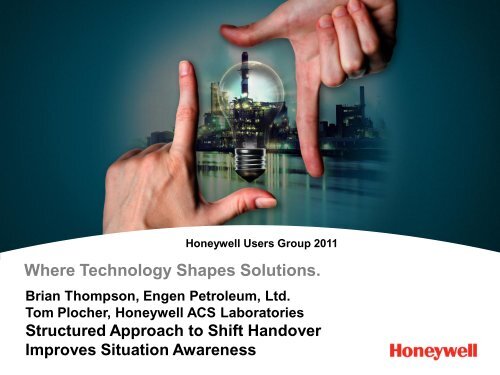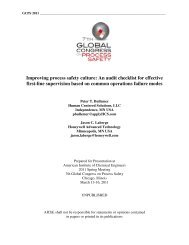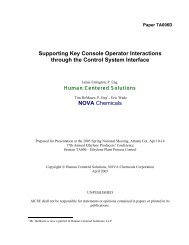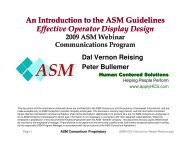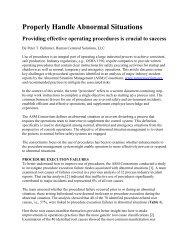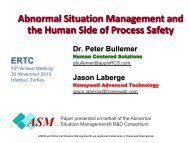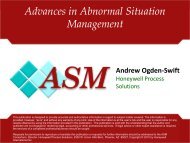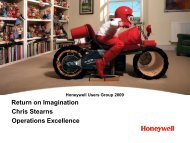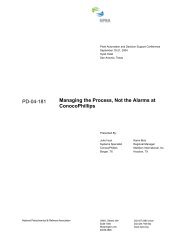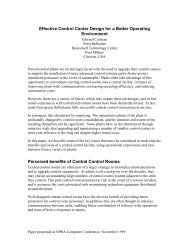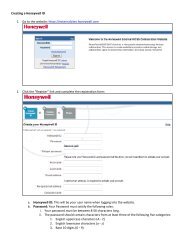Structured Approach to Shift Handover Improves ... - ASM Consortium
Structured Approach to Shift Handover Improves ... - ASM Consortium
Structured Approach to Shift Handover Improves ... - ASM Consortium
Create successful ePaper yourself
Turn your PDF publications into a flip-book with our unique Google optimized e-Paper software.
Honeywell Users Group 2011<br />
Where Technology Shapes Solutions.<br />
Brian Thompson, Engen Petroleum, Ltd.<br />
Tom Plocher, Honeywell ACS Labora<strong>to</strong>ries<br />
<strong>Structured</strong> <strong>Approach</strong> <strong>to</strong> <strong>Shift</strong> <strong>Handover</strong><br />
<strong>Improves</strong> Situation Awareness
Topics<br />
• Introduction<br />
• Background <strong>to</strong> problem<br />
• Experiment Overview<br />
• Experiment Details<br />
• Project Results<br />
• Best Practices<br />
• Conclusion<br />
2
Introduction<br />
• In the refining industry, control room and field<br />
opera<strong>to</strong>rs document their daily activities using<br />
shift logs<br />
• <strong>Shift</strong> logs are an important part of the shift handover<br />
process and are the mechanism by which activities<br />
are coordinated and situation<br />
awareness is shared<br />
across shifts<br />
• Industrial research has argued<br />
for the benefits of imposing<br />
structure on shift handovers<br />
in the form of structured logs,<br />
checklists, and displays<br />
3
Background<br />
• Approximately 80% of industrial operations lack a<br />
structured approach <strong>to</strong> shift handovers<br />
• Numerous disasters have illustrated the potential<br />
consequences of poor shift handovers<br />
• Lack of structure increases likelihood that critical<br />
information will be missed and<br />
misunderstandings will occur<br />
• Value of a structured approach<br />
has never been demonstrated<br />
experimentally<br />
4
Background (Cont’d)<br />
• Examples of disasters attributed in part <strong>to</strong> inaccurate<br />
or incomplete communication of information from shift<br />
<strong>to</strong> shift<br />
– 1968: Fire and explosion on the Piper Alpha offshore platform<br />
due <strong>to</strong> poorly documented relief valve status<br />
– 2002: Pipefitter exposed <strong>to</strong> <strong>to</strong>xic chemical at an undisclosed<br />
facility due <strong>to</strong> poorly documented tank maintenance status<br />
– 2005: Fire and explosion at the BP refinery in Texas City, TX,<br />
due <strong>to</strong> failure <strong>to</strong> log information, resulting in flammable liquid<br />
overfill condition<br />
5
Background (Cont’d)<br />
• Most common causes of incidents related <strong>to</strong> shift<br />
handover<br />
– Poor logbook design<br />
• Lack of structure<br />
• No clear indication about what <strong>to</strong> log and how <strong>to</strong> structure entries<br />
– Poorly conducted shift handovers<br />
• Lack of complete and accurate reporting<br />
• Reliance on opera<strong>to</strong>r memory<br />
• Time pressures<br />
• Ineffective two-way communications<br />
6
Recent Experiment<br />
• <strong>Shift</strong> handover experiment was sponsored by<br />
<strong>ASM</strong> ® <strong>Consortium</strong> and conducted by Engen<br />
Petroleum, Ltd., Honeywell, Inc. and Nanyang<br />
University of Singapore<br />
• Engen is an Africa-based energy company<br />
focused on downstream refined<br />
petroleum products<br />
• Engen’s Durban, South<br />
Africa, refinery has capacity<br />
<strong>to</strong> refine 135,000 barrels<br />
of crude oil per day<br />
7
Recent Experiment (Cont’d)<br />
• Experiment at the Durban refinery compared the quality<br />
of shift handovers using a structured checklistintegrated<br />
logbook <strong>to</strong> a traditional, less structured<br />
logging approach<br />
• Tests focused on shift handover between first shift and<br />
second shift opera<strong>to</strong>rs<br />
• Checklist-integrated shift log provided sub-categories of<br />
information, which prompted opera<strong>to</strong>rs <strong>to</strong> acknowledge<br />
each detail even if there was nothing relevant <strong>to</strong> report<br />
• To ensure statistical robustness, ten test trials of the<br />
semi-structured handover and ten trials of the<br />
structured handover were conducted and observed<br />
8
Recent Experiment Details<br />
• Standard Engen logbook<br />
9
Recent Experiment Details (Cont’d)<br />
• Checklist-integrated logbook<br />
10
Recent Experiment Details (Cont’d)<br />
• Test plan and participants<br />
– 20 console opera<strong>to</strong>rs with varying experience<br />
• 1 <strong>to</strong> 25 years behind DCS (median = 6.5)<br />
• 6 <strong>to</strong> 35 years of operations experience (median = 20.35)<br />
• 27-62 years of age (median = 39.5)<br />
– 20 opera<strong>to</strong>rs 10 pairs of Opera<strong>to</strong>r 1 & Opera<strong>to</strong>r 2<br />
• Trial A: Opera<strong>to</strong>r 1 hands off <strong>to</strong> Opera<strong>to</strong>r 2<br />
• Trial B: Opera<strong>to</strong>r 2 hands off <strong>to</strong> Opera<strong>to</strong>r 1<br />
• New integrated logbook introduced during every second trial of the<br />
day<br />
• Two scenarios (power failure & steam leak) alternated between<br />
Trial A & B<br />
11
Recent Experiment Details (Cont’d)<br />
• Experiment pro<strong>to</strong>col<br />
12
Recent Experiment Details (Cont’d)<br />
• Opera<strong>to</strong>r test setup<br />
13
Recent Experiment Details (Cont’d)<br />
• Experienced opera<strong>to</strong>rs were put through two simulated<br />
emergency scenarios<br />
– Steam pipe rupture<br />
– Power failure that caused pumps <strong>to</strong> fail<br />
• The scenarios were designed <strong>to</strong> force a significant<br />
amount of interaction between the console opera<strong>to</strong>r,<br />
field opera<strong>to</strong>rs, supervisor and other plant opera<strong>to</strong>rs<br />
• Opera<strong>to</strong>rs had <strong>to</strong> recognize abnormal situation, shut<br />
down affected unit, and communicate status of situation<br />
<strong>to</strong> second shift opera<strong>to</strong>r during shift handover<br />
• Second shift opera<strong>to</strong>r’s task was <strong>to</strong> understand situation<br />
and safely bring unit back in<strong>to</strong> operation<br />
14
Recent Experiment Details (Cont’d)<br />
• Events of each scenario were designed <strong>to</strong> include at<br />
least one instance of each information category in the<br />
checklist-integrated logbook, thus generating a<br />
significant number of key items of information affecting<br />
unit startup during the second shift<br />
• Additional events, not related specifically <strong>to</strong> the checklist,<br />
were included in the scenarios <strong>to</strong> serve as distractions<br />
• Scenarios were designed <strong>to</strong> force a significant amount of<br />
interaction between console opera<strong>to</strong>r and various other<br />
plant personnel such as field opera<strong>to</strong>rs and supervisors,<br />
role-played by senior operations engineers from the<br />
Engen refinery<br />
15
Recent Experiment Details (Cont’d)<br />
• Data collected during experiment<br />
– Digital audio recording of the entire experimental session<br />
– Completed <strong>Shift</strong> logs<br />
– Still pho<strong>to</strong>s<br />
– Scripts and probes<br />
16
Experiment Results<br />
• Engen’s experiment showed the benefits <strong>to</strong> situation<br />
awareness that derive from the more structured shift<br />
handover approach<br />
– Checklist-integrated logbook generated higher-quality log<br />
entries compared <strong>to</strong> model logbook entries generated by<br />
Engen operations experts (+18.6%)<br />
– Second shift opera<strong>to</strong>rs were able <strong>to</strong> provide more accurate<br />
and comprehensive account of the unit situation (+9%)<br />
– Opera<strong>to</strong>rs were better at answering questions without the<br />
need <strong>to</strong> consult supervisors and team members (8%)<br />
– <strong>Structured</strong> handovers <strong>to</strong>ok only a minute or so longer than<br />
those conducted in less structured way (+16%)<br />
17
Project Results<br />
• Based on the experiment outcome, a structured shift<br />
log has now been rolled out at the Engen refinery<br />
• Although the introduction was generally successful, it<br />
revealed some key issues<br />
– <strong>Structured</strong> logbook is much longer than the previous<br />
electronic logbook<br />
– Acceptance of the log as a<br />
structured handover <strong>to</strong>ol has<br />
not been fully entrenched<br />
– Too much usage of the “Other”<br />
fields <strong>to</strong> communicate<br />
information remains<br />
18
Project Results (Cont’d)<br />
• Engen’s ongoing change management effort will<br />
address remaining issues<br />
– Follow up training <strong>to</strong> reinforce behavior change<br />
– Development of separate shift<br />
handover report that is a<br />
distinct subset of the full<br />
reporting log<br />
19
Best Practices<br />
• Engen’s experience with the structured shift handover<br />
experiment has been used <strong>to</strong> implement the following<br />
best practices<br />
– Use structured shift logs clearly indicating what should be<br />
reported in the handover presentation<br />
• Structure shift logs around vital categories and subdivisions of<br />
information needed by incoming second shift opera<strong>to</strong>r<br />
– Set clear expectations for complete and accurate shift<br />
handovers and for individual responsibility<br />
• Require outgoing first shift opera<strong>to</strong>r <strong>to</strong> acknowledge every key<br />
category of information in the logbook during shift handover, even<br />
if no new events have occurred during his or her shift<br />
20
Best Practices (Cont’d)<br />
– Plan ahead for sufficient time <strong>to</strong> conduct a complete shift<br />
handover<br />
– Train opera<strong>to</strong>rs in the skill of conducting effective shift<br />
handovers and in effective two-way communication<br />
– Emphasize <strong>to</strong> both first and second shift opera<strong>to</strong>rs that they<br />
have a joint responsibility for effective communication of the<br />
situation<br />
21
Conclusion<br />
• <strong>Shift</strong> handovers are more effective when supported by<br />
a structured shift log based on a checklist of important<br />
categories of plant information<br />
– Differences are not large, but evidential statistical trends exist<br />
– Results are consistent across all measures of shift handover<br />
effectiveness<br />
• <strong>Structured</strong> approach reduces risk that critical<br />
information is not communicated during a shift change<br />
• Accurate and consistent understanding of plant<br />
situation is shared from shift <strong>to</strong> shift<br />
22
23<br />
Question & Answer
24<br />
Thank You


